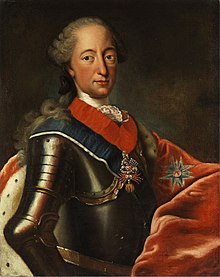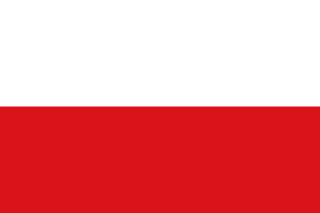
Upper Austria is one of the nine states or Länder of Austria. Its capital is Linz. Upper Austria borders Germany and the Czech Republic, as well as the other Austrian states of Lower Austria, Styria, and Salzburg. With an area of 11,982 km2 (4,626 sq mi) and 1.49 million inhabitants, Upper Austria is the fourth-largest Austrian state by land area and the third-largest by population.

Braunau am Inn is a town in Upper Austria on the border with Germany. It is known for being the birthplace of Adolf Hitler.

Bundesautobahn 94 is an autobahn in southern Germany. When completed, it will connect Munich with Passau. Currently, only the parts Munich-Burghausen, and Malching-Kirchham have been built. Between Burghausen and Simbach am Inn, there is a 14 kilometer, two-lane section that is signed as Bundesstraße 12. Provisions for an upgrade to A 94 exist here.

Ried im Innkreis is a town in the Austrian state of Upper Austria, approximately 70 km (43 mi) west of Linz and 60 km (37 mi) north of Salzburg. It is the capital of the district of Ried im Innkreis, and it serves as the administrative centre for the Innviertel region.
The Treaty of Teschen was signed on 13 May 1779 in Teschen, then in Austrian Silesia, between the Austrian Habsburg monarchy and the Kingdom of Prussia, which officially ended the War of the Bavarian Succession.
Bezirk Braunau is a district of the state of Upper Austria in Austria.

The Braunau Parliament is the name of the congress on the defence of the state of Bavaria held at Braunau am Inn convened on 21 December 1705, during the War of the Spanish Succession and often seen as the precursor of the Bavarian parliament.
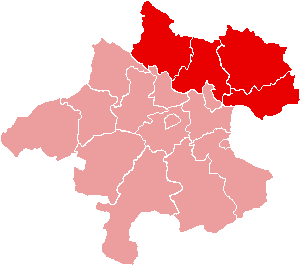
The Mühlviertel is an Austrian region belonging to the state of Upper Austria: it is one of four "quarters" of Upper Austria, the others being Hausruckviertel, Traunviertel, and Innviertel. It is named after the three rivers Große Mühl, Kleine Mühl, and Steinerne Mühl.
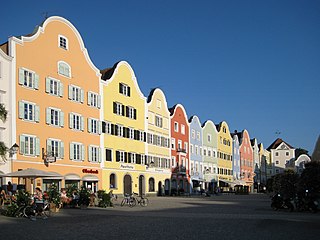
Schärding is a town in the northern Austrian state of Upper Austria, the capital of the district of the same name, and a major port on the Inn River. Historically, it was owned by the Wittelsbach family, which is reflected in the town's architecture.
Hohenzell is a municipality in Upper Austria. It is situated in the district of Ried im Innkreis in the Innviertel and has 2,002 inhabitants. The responsible jurisdiction is Ried im Innkreis.

Neuhofen im Innkreis is a municipality in Upper Austria in the district of Ried im Innkreis.

Mehrnbach is a municipality in Upper Austria. It is situated in the district of Ried im Innkreis in the Innviertel.

The Nomenclature of Territorial Units for Statistics (NUTS) is a geocode standard for referencing the subdivisions of Austria for statistical purposes. The standard is developed and regulated by the European Union. The NUTS standard is instrumental in delivering the European Union's Structural Funds. The NUTS code for Austria is AT and a hierarchy of three levels is established by Eurostat. Below these is a further levels of geographic organisation - the local administrative unit (LAU). In Austria, the LAU 2 is municipalities.

Maria Schmolln is a municipality in the district of Braunau am Inn of the Austrian state of Upper Austria state. The community is mainly known as an important pilgrimage destination among rural Innviertel. The name comes from its location on the “Schmollner Berg”, literally small mountain.
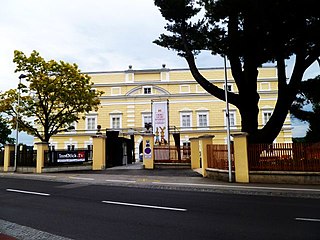
Mattighofen is a town in the district of Braunau am Inn, part of the Innviertel region, in the Austrian state of Upper Austria.

St. Radegund is a municipality in the district of Braunau in the Austrian state of Upper Austria, named after Saint Radegund. It is situated at the western rim of the Innviertel region, where the Salzach river forms the border to the German state of Bavaria.

St. Martin im Innkreis is a municipality in Ried District, in the Austrian state of Upper Austria.
Ammerer Bed Company is an Austrian family business operating in its eighth generation, established in 1763. Specialising in sleeping systems and textile design, their services encompass a range of activities including a curtain-sewing workshop, bed sanitisation, furniture upholstery, home servicing, mattress delivery and disposal, monogram embroidery, 3D room planning, as well as the organisation of wedding tables.
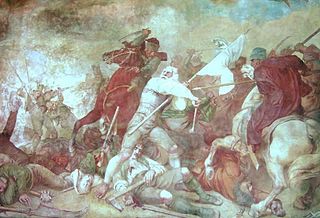
The Bavarian uprising of 1705–1706 was a revolt against the occupation of the Electorate of Bavaria by the Imperial Army of the Habsburg Monarchy during the War of the Spanish Succession (1701–1714). It lasted from early November 1705 to 18 January 1706, approximately 75 days. Henric L. Wuermeling speaks of this as "the first revolution of modern history."

The Wels–Passau railway—also called the Passauer Bahn in German—is a two-track, electrified main line railway mainly in Austria, which was originally owned and operated by the k.k. privilegierte Kaiserin Elisabeth-Bahn company. It runs from Wels in Upper Austria to Passau in Bavaria and is part of the core network of the Austrian Federal Railways.






